Coastal Dunes Geomorphosites to Develop the Geotourism in a Volcanic Subtropical Oceanic Island, Tenerife, Spain
Abstract
1. Introduction
2. Study Area
3. Methodology
3.1. Distibution, Identification, Selection and Inventory of Geomorphosites
3.2. Characterisation of Geomorphosites
3.3. Evaluation of Geomorphosites
4. Results and Discussion
4.1. Distribution, Inventory and Characterisation of Aeolian Depositional Geomorphosites
4.2. Land Uses and the Cultural Landscape
4.3. Quantitative Assessment of the Intrinsic Value of Geomorphosites
- Low: geomorphosites with low scientific values, which in turn correspond to those with low added values because they are palaeodunes that are severely deteriorated by tourist developments (Puerto de la Cruz) or because they have a small surface area of only a few square metres (La Caleta).
- Medium: aeolian depositional systems with medium scientific values and added values with low (Abades), medium (Igueste de San Andrés) and high (Socorro-Malpaís de Güímar and Los Gigantes) scores.
- High: geomorphosites with high scientific values and additional scores in all three intervals. Of this last group, El Médano-Montaña Roja is the only geomorphosite with high scores for both scientific and additional values, which is, as mentioned above, a consequence of its rich and varied natural and cultural heritage associated with the diversity of the volcanic process and forms and important land uses.
5. General Discussion
6. Final Remarks and Recommendations
Author Contributions
Funding
Institutional Review Board Statement
Informed Consent Statement
Acknowledgments
Conflicts of Interest
References
- Steffen, W.; Sanderson, A.; Jäger, J.; Tyson, P.D.; Moore, B., III; Matson, P.A.; Richardson, K.; Oldfield, F.; Schellnhuber, H.J.; Turner, B.L., II; et al. Global Change and the Earth System: A Planet under Pressure; Springer: Heidelberg, Germany, 2004. [Google Scholar]
- Cohen, J.E.; Small, C.; Mellinger, A.; Gallup, J.; Sachs, J. Estimates of coastal populations. Science 1997, 278, 1211. [Google Scholar] [CrossRef]
- Mimura, N.; Nurse, L.; McLean, R.F.; Agard, J.; Briguglio, L.; Lefale Payet, P.; Sem, G. Small islands. Clim. Chang. 2007, 16, 687–716. [Google Scholar]
- Ferrer-Valero, N.; Hernández-Calvento, L.; Hernández-Cordero, A.I. Human impacts quantification on the coastal landforms of Gran Canaria Island (Canary Islands). Geomorphology 2017, 286, 58–67. [Google Scholar] [CrossRef]
- Dóniz-Páez, J.; Beltrán-Yanes, E.; Becerra-Ramírez, R.; Pérez, N.; Hernández, P.; Hernández, W. Diversity of volcanic geoheritage in the Canary Islands, Spain. Geosciences 2020, 10, 390. [Google Scholar] [CrossRef]
- Schaefer-Pereira, L.; Franco-Alves, A. Geotouristic Coastal Itinerary in the South Coast of Paraíba (Northeast of Brazil). Geoconservation 2020, 3, 58–76. [Google Scholar] [CrossRef]
- Thomas, D.S.G.; Wiggs, G.F.S. Aeolian system responses to global change: Challenges of scale, process and temporal integration. Earth Surf. Processes Landf. 2008, 33, 1396–1418. [Google Scholar] [CrossRef]
- Martínez, P.; Hesp, P.; Gallego-Fernández, J. Coastal Dunes: Human Impact and Need for Restoration. In Restoration of Coastal Dunes, Springer Series on Environmental Management; Martínez, P., Hesp, P., Gallego-Fernández, J., Eds.; Springer: Berlin/Heidelberg, Germany, 2013; pp. 1–14. [Google Scholar] [CrossRef]
- Tsoar, H.; Blumberg, D.G. Formation of parabolic dunes from barchan and transverse dunes along Israel’s Mediterranean coast. Earth Surf. Processes Landf. 2002, 27, 1147–1161. [Google Scholar] [CrossRef]
- Kutiel, P.; Cohena, O.; Shoshany, M.; Shubb, M. Vegetation establishment on the southern Israeli coastal sand dunes between the years 1965 and 1999. Landsc. Urban Plan. 2004, 67, 141–156. [Google Scholar] [CrossRef]
- Koster, E. The “European Aeolian Sand Belt”: Geoconservation of Drift Sand Landscapes. Geoheritage 2009, 1, 93–110. [Google Scholar] [CrossRef]
- Marrero-Rodríguez, N.; García-Romero, L.; Sánchez-García, M.J.; Hernández-Calvento, L.; Pérez-Chacón, E. An historical ecological assessment of land-use evolution and observed landscape change in an arid aeolian sedimentary system. Sci. Total Environ. 2020, 716, 137087. [Google Scholar] [CrossRef]
- Leite-Mansur, K.; de Souza-Carvalho, I. Characterization and Valuation of the Geological Heritage Identified in the Peró Dune Field, State of Rio de Janeiro, Brazil. Geoheritage 2011, 3, 97–115. [Google Scholar] [CrossRef]
- Mateos, R.M.; Durán, J.J.; Robledo, P.A. Marès Quarries on the Majorcan Coast (Spain) as Geological Heritage Sites. Geoheritage 2011, 3, 41–54. [Google Scholar] [CrossRef]
- Sytnik, O.; Stecchi, F. Disappearing coastal dunes: Tourism development and future challenges, a case-study from Ravenna, Italy. J. Coast. Conserv. 2015, 19, 715–727. [Google Scholar] [CrossRef]
- García-Romero, L.; Henández-Cordero, A.; Fernandéz-Cabrera, E.; Peña, C.; Hernández-Calvento, L.; Pérez-Chacón, E. Urban-touristic impacts on the aeolian sedimentary systems of the Canary Islands: Conflict between development and conservation. Isl. Stud. J. 2016, 11, 91–112. [Google Scholar]
- Garcia-Romero, L.; Delgado-Fernandez, I.; Hesp, P.A.; Hernández-Calvento, L.; Hernández-Cordero, A.I.; Viera-Pérez, M. Biogeomorphological processes in an arid transgressive dunefield as indicators of human impact by urbanization. Sci. Total Environ. 2019, 650, 73–86. [Google Scholar] [CrossRef] [PubMed]
- Marrero-Rodríguez, N.; García-Romero, L.; Peña-Alonso, C.; Hernández-Cordero, A.I. Biogeomorphological responses of nebkhas to historical long-term land uses in an arid coastal aeolian sedimentary system. Geomorphology 2020, 368, 107348. [Google Scholar] [CrossRef]
- Hernández-Cordero, A.I.; Hernández-Calvento, L.; Hesp, P.A.; Pérez-Chacón, E. Geomorphological changes in an arid transgressive coastal dune field due to natural processes and human impacts. Earth Surf. Processes Landf. 2018, 43, 2167–2180. [Google Scholar] [CrossRef]
- Cabrera-Vega, L.L.; Cruz-Avero, N.; Hernández-Calvento, L.; Hernández-Cordero, A.; Fernández-Cabrera, E. Morphological changes in dunes as an indicator of anthropogenic interferences in arid dune fields. J. Coast. Res. 2013, 65, 1271–1276. [Google Scholar] [CrossRef]
- Arens, S.M.; Slings, Q.L.; Geelen, L.H.; Van der Hagen, H.G. Restoration of dune mobility in the Netherlands. In Restoration of Coastal Dunes; Springer: Berlin/Heidelberg, Germany, 2013; pp. 107–124. [Google Scholar]
- Roig, I.; Munar, F.; Rodríguez-Perera, A.; Martín Prieto, J. Análisis crítico de las medidas de valoración en la calidad turística y ambiental de los sistemas arenosos. Territoris 2006, 6, 27–44. [Google Scholar]
- Roig, I.; Munar, F.; Rodríguez-Perera, A.; Pons, G.; Martín Prieto, J. Análisis de técnicas de gestión litoral en las Islas Baleares (España) mediante su valoración geoambiental y económica. Rev. Medio Ambiente Tur. Sustentabilidad. 2009, 2, 57–66. [Google Scholar]
- Peña-Alonso, C.; Ariza, E.; Hernández-Calvento, L.; Pérez-Chacón, E. Exploring multi-dimensional recreational quality of beach socio-ecological systems in the Canary Islands (Spain). Tour. Manag. 2018, 64, 303–313. [Google Scholar] [CrossRef]
- Gracia-Prieto, F.J. Introducción al Volumen Especial. Geomorfología y Gestión de Espacios Naturales. Cuatern. Geomorfol. 2009, 23, 8–9. [Google Scholar]
- Nordstrom, K. Beach and Dune Restoration; Cambridge University Press: Cambridge, UK, 2008. [Google Scholar]
- Rozé, F.; Lemauviel, S. Sand dune restoration in North Brittany, France: A 10-year monitoring study. Restor. Ecol. 2004, 12, 29–35. [Google Scholar] [CrossRef]
- Lithgow, D.; Martínez, M.L.; Gallego-Fernández, J.B.; Hesp, P.A.; Flores, P.; Gachuz, S.; Rodríguez-Revelo, N.; Jiménez-Orocio, O.; Mendoza-González, G.; Álvarez-Molina, L.L. Linking restoration ecology with coastal dune restoration. Geomorphology 2013, 199, 214–224. [Google Scholar] [CrossRef]
- Fernández-Montblanc, T.; Duoa, E.; Ciavola, P. Dune reconstruction and revegetation as a potential measure to decrease coastal erosion and flooding under extreme storm conditions. Ocean Coast. Manag. 2020, 188, 105075. [Google Scholar] [CrossRef]
- Maghsoudi, M.; Moradi, A.; Moradipour, F.; Nezammahalleh, M.A. Geotourism development in world heritage of the Lut Desert. Geoheritage 2019, 11, 501–516. [Google Scholar] [CrossRef]
- Maghsoudi, M.; Moradi, A.; Moradipour, F. Aerial Geotourism: New Branch of Geotourism for Promoting Geoconservation (Examples from Iran). Geoheritage 2021, 13, 4. [Google Scholar] [CrossRef]
- Ghazi, I.; Ghadiri, N. Assessing Geotourism Capabilities of Kavir National Park by Applying the “Freeman” Management Strategy Model. J. Environ. Stud. 2012, 37, 65–78. [Google Scholar]
- Doktor, M.; Miśkiewicz, K.; Welc, E.; Mayer, W. Criteria of geotourism valorization specified for various recipients. Geotourism/Geoturystyka 2015, 42–43, 25–38. [Google Scholar] [CrossRef]
- Hose, T.A.; Vasiljević, D.A. Defining the nature and purpose of modern geotourism with particular reference to the United Kingdom and South-East Europe. Geoheritage 2012, 4, 25–43. [Google Scholar] [CrossRef]
- Alonso, I.; Hernández-Calvento, L.; Alcántara-Carrió, J.; Cabrera, L.; Yanes, A. Los grandes campos de dunas actuales de Canarias. In Las Dunas en España; Sanjaume, E., Gracia, J., Eds.; SEG: Houston, TX, USA, 2011; pp. 467–496. [Google Scholar]
- Hernández-Cordero, A.I.; Peña-Alonso, C.; Hernández-Calvento, L.; Ferrer-Valero, N.; Santana-Cordero, A.M.; García-Romero, L.; Pérez-Chacón, E. Aeolian Sedimentary Systems of the Canary Islands. In The Spanish Coastal Systems; Morales, J.A., Ed.; Springer: Cham, Switzerland, 2019; pp. 699–725. [Google Scholar]
- Yanes, A. Morfología Litoral de las Islas Canarias Occidentales; Universidad de La Laguna: Santa Cruz de Tenerife, Spain, 1990. [Google Scholar]
- Kröchert, J.; Maurer, H.; Buchner, E. Fossil beaches as evidence for significant uplift of Tenerife, Canary Islands. J. Afr. Earth Sci. 2008, 51, 220–234. [Google Scholar] [CrossRef]
- Butler, R. The concept of a tourist area cycle of evolution: Implications for management of resources. Can. Geogr. 1980, 24, 5–12. [Google Scholar] [CrossRef]
- Dóniz-Páez, F.J.; Hernández, P.; Pérez, N.; Hernández, W.; Márquez, A. TFgeotourism: A project to quantify, highlight, and promote the volcanic geoheritage and geotourism in Tenerife (Canary Islands, Spain). In Volcanoes—Updates in Volcanology; En Németh, K., Ed.; Intechopen: London, UK, 2022. [Google Scholar] [CrossRef]
- Romero Ruiz, C.; Dóniz-Páez, J. Los relieves volcánicos españoles. In Mapa Geomorfológico de España y del Margen Continental, Escala 1:1000.000; Martín-Serrano, A., Ed.; Ministerio de Educación y Ciencia; IGME: Madrid, Spain, 2005; pp. 159–172. [Google Scholar]
- Yanes, A.; Criado-Hernández, C. Paleodunas organógenas de la costa NE. de Tenerife (Canarias). In Actas 1 Reunión Nacional de Geomorfología: Teruel, 17–20 September 1990; Instituto de Estudios Turolenses: Teruel, Spain, 1990; pp. 329–340. [Google Scholar]
- Morales, G.; Pérez, R. Gran Atlas Temático de Canarias. Interinsular Canaria, Santa Cruz de Tenerife; Biblioteca Virtual Miguel de Cervantes: Alicante, Spain, 2000; pp. 87–106. [Google Scholar]
- Reynard, E.; Fontana, G.; Kozlik, L.; Scapozza, C. A method for assessing the scientific and additional values of geomorphosites. Geogr. Helv. 2007, 62, 148–158. [Google Scholar] [CrossRef]
- Moufti, M.; Németh1, K.; El-Masry, N.; Qaddah, A. Geoheritage values of one of the largest maar craters in the Arabian Peninsula: The Al Wahbah Crater and other volcanoes (Harrat Kishb, Saudi Arabia). Cent. Eur. J. Geosci. 2013, 5, 254–271. [Google Scholar] [CrossRef]
- Reynard, E.; Perret, A.; Bussard, J.; Grangier, L.; Martin, S. Integrated approach for the inventory and management of geomorphological heritage at the regional scale. Geoheritage 2016, 8, 43–60. [Google Scholar] [CrossRef]
- Bouzekraoui, H.; Barakat, A.; Touhami, F.; Mouaddine, A.; El Youssi, M. Inventory and assessment of geomorphosites for geotourism development: A case study of Aït Bou Oulli valley (Central High-Atlas, Morocco). Area 2017, 50, 331–343. [Google Scholar] [CrossRef]
- Pérez-Umaña, D.; Quesada, A.; De Jesús-Rojas, J.; Zamorano, J.; Dóniz-Páez, J.; Becerra-Ramírez, R. Comparative Analysis of Geomorphosites in Volcanoes of Costa Rica, Mexico, and Spain. Geoheritage 2019, 11, 545–559. [Google Scholar] [CrossRef]
- Pérez-Umaña, D.; Quesada, A.; Tefogoum, G. Geomorphological heritage inventory of Irazú Volcano, Costa Rica. Int. J. Geoheritage Parks 2020, 8, 31–47. [Google Scholar] [CrossRef]
- Dóniz-Páez, J.; Becerra-Ramírez, R. Geomorfositios de interés volcano turístico en una montaña subtropical: El parque nacional del Teide (Canarias, España). Pirineos 2020, 175, e061. [Google Scholar] [CrossRef]
- Zangmo-Tefogoum, G.; Quesada-Román, A.; Pérez-Umaña, D. Geomorphosites inventory in the Eboga Volcano (Cameroon): Contribution for geotourism promotion. Géomorphol. Relief Process. Environ. 2020, 26, 19–33. [Google Scholar] [CrossRef]
- Kubalíková, L. Geomorphosite assessment for geotourism purposes. Czech J. Tour. 2013, 2, 80–104. [Google Scholar] [CrossRef]
- González, M.; Serrano, E.; González, M. Lugares de interés geomorfológico, geopatrimonio y gestión de espacios naturales protegidos: El Parque Natural de Valderejo (Álava, España). Rev. Geogr. Norte Gd. 2014, 59, 45–64. [Google Scholar] [CrossRef]
- Archontikis, O.A. Revealing the Geoheritage of Attica and Eastern Peloponnes through Geotouristic Routes. Master’s Thesis, National and Kapodistrian University of Athens, Athens, Greece, 2017. [Google Scholar]
- González-de Vallejo, L.I.; Tsigé, M.; Cabrera, L. Paleoliquefaction features on Tenerife (Canary Islands) in Holocene sand deposits. Eng. Geol. 2005, 76, 179–190. [Google Scholar] [CrossRef][Green Version]
- Carmona, J.; Romero, C.; Dóniz-Páez, J.; García, A. Characterization and facies analysis of the hydrovolcanic deposits of Montaña Pelada tuff ring: Tenerife, Canary Islands. J. Afr. Earth Sci. 2011, 59, 41–50. [Google Scholar] [CrossRef]
- Santana-Cordero, A.; Monteiro-Quintana, M.L.; Hernández-Calvento, L.; Pérez-Chacón, E.; García-Romero, L. Long-term Human Impacts on the Coast of La Graciosa, Canary Islands. Land Degrad. Dev. 2016, 27, 479–489. [Google Scholar] [CrossRef]
- Santana-Santana, S.B.; Peña-Alonso, C.; Pérez-Chacón, E. Assessing physical accessibility conditions to tourist attractions. The case of Maspalomas Costa Canaria urban area (Gran Canaria, Spain). Appl. Geogr. 2020, 125, 102327. [Google Scholar] [CrossRef]
- Nordstrom, K.F. Beaches and Dunes of Developed Coasts; Cambridge University Press: Cambridge, UK, 2004. [Google Scholar]
- Sanromualdo-Collado, A.; García-Romero, L.; Peña-Alonso, C.; Hernández-Cordero, A.I.; Ferrer-Valero, N.; Hernández-Calvento, L. Spatiotemporal analysis of the impact of artificial beach structures on biogeomorphological processes in an arid beach-dune system. J. Environ. Manag. 2021, 282, 111953. [Google Scholar] [CrossRef]
- Dóniz-Páez, J. Geografía, homosexualidad masculina y cruising en Tenerife (Canarias, España). Rev. Lat.-Am. Geogr. Gênero 2015, 6, 177–191. [Google Scholar] [CrossRef]
- Rickard, C.A.; McLachlan, A.; Kerley, G.I.H. The effects of vehicular and pedestrian traffic on dune vegetation in South Africa. Ocean Coast. Manag. 1994, 23, 225–247. [Google Scholar] [CrossRef]
- Dóniz-Páez, J.; Romero Ruiz, C.; Coello de la Plaza, E.; Criado, C. Características geomorfológicas de los debris flows recientes del volcán basáltico monogénico de Montaña Roja (Tenerife, Canarias, España). In Avances en Estudios Sobre Desertificación-ICOD; Romero Díaz, A., López Serrato, F., Alonso Sarria, F., López Bermúdes, F., Eds.; Editum-Murcia: Murcia, Spain, 2009; pp. 469–472. [Google Scholar]
- Dóniz-Páez, J.; Hernández, W.; Przeor, M.; Pérez, N. Guía geoturística de Tenerife; Instituto Volcanológico de Canarias: San Cristóbal de La Laguna, Spain, 2019; 114p. [Google Scholar]
- Dowling, R.K. Global geotourism—An Emerging Form of Sustainable Tourism. Czech J. Tour. 2013, 826, 59–79. [Google Scholar] [CrossRef]
- Ólafsdóttir, R.; Tverijonaite, E. Geotourism: A systematic literature review. Geosciences 2018, 8, 234. [Google Scholar] [CrossRef]
- Dowling, R.; Newsome, D. Geotourism: Definition, characteristics and international perspectives. In Handbook of Geotourism; Edward Elgar: Cheltenham, UK, 2018; pp. 1–22. [Google Scholar]
- Hose, A. Selling the story of Britain’s stone. Environ. Interpret. 1995, 10, 16–17. [Google Scholar]
- Hose, A. Towards a history of geotourism: Definitions, antecedents and the future. Geol. Soc. Lond. Spec. Publ. 2008, 300, 37–60. [Google Scholar] [CrossRef]
- Newsome, D.; Dowling, R. Geotourism: The Tourism of Geology and Landscape; Goodfellow Publishers: Oxford, UK, 2010; p. 320. [Google Scholar]
- Carcavilla, L.; Belmonte, A.; Durán, J.; Hilario, A. Geoturismo: Concepto y perspectivas en España. Enseñ. Cienc. Tierra 2011, 19, 81–94. [Google Scholar]
- Tourtellot, J.B. Geotourism for Your Community. In National Geographic Drafts; National Geographic: Washington, DC, USA, 2000; p. 2. [Google Scholar]
- Stokes, A.M.; Cook, S.D.; Drew, D. Geotourism: The New Trend in Travel; Travel Industry America and National Geographic Traveler: Washington, DC, USA, 2003; p. 65. [Google Scholar]
- Pralong, J.P. Geotourism: A new form of tourism utilising natural landscapes and based on imagination and emotion. Tour. Rev. 2006, 61, 20–25. [Google Scholar] [CrossRef]
- National Geographic. What Is Geotourism? Center for Sustainable Destinations; National Geographic: Washington, DC, USA, 2010; Available online: www.nationalgeographic.com/travel/sustainable (accessed on 17 February 2022).
- National Geographic Society. Geotourism Principles; National Geographic Society: Washington, DC, USA, 2020; Available online: www.nationalgeographic.com/maps/geotourism/geotourism-principles/ (accessed on 17 February 2022).
- Arouca Declaration. International Congress of Geotourism, Geopark Arouca, Portugal. 2011. Available online: http://www.europeangeoparks.org/?p=223 (accessed on 17 February 2022).
- Millán, M. La función didáctica del geoturismo. Propuesta para la Región de Murcia. Gran Tour 2011, 4, 62–93. [Google Scholar]
- Sánchez-Cortez, J.; Simbaña-Tasiguano, M. Los Geoparques y su implantación en América Latina. Estud. Geográficos 2018, 79, 445–467. [Google Scholar] [CrossRef]
- Becerra-Ramírez, R.; Gosálvez, R.U.; Escobar, E.; González, E.; Serrano-Patón, M.; Guevara, D. Characterization and Geotourist Resources of the Campo de Calatrava Volcanic Region (Ciudad Real, Castilla-La Mancha, Spain) to Develop a UNESCO Global Geopark Project. Geosciences 2020, 10, 441. [Google Scholar] [CrossRef]
- Beltrán-Yanes, E.; Dóniz-Páez, J.; Esquivel-Sigut, I. Chinyero Volcanic Landscape Trail (Canary Islands, Spain): A Geotourism Proposal to Identify Natural and Cultural Heritage in Volcanic Areas. Geosciences 2020, 10, 453. [Google Scholar] [CrossRef]
- Sigurdsson, H.; Lopes, R. Volcanoes and Tourism. In Encyclopedia of Volcanoes; Sigurdsson, H., Rymer, H., Houghton, B., Stix, J., McNutt, S., Eds.; Academic Press: San Diego, CA, USA, 2000; pp. 1283–1299. [Google Scholar]
- Dóniz-Páez, J. Turismo Volcánico. In Canarias: Productos Turísticos y Propuesta de Itinerarios Volcánicos; Editorial Académica Alemana: Madrid, Spain, 2012; 115p. [Google Scholar]
- Kutiel, P.; Zhevelev, H.; Harrison, R. The effect of recreational impacts on soil and vegetation of stabilised Coastal Dunes in the Sharon Park, Israel. Ocean Coast. Manag. 1999, 42, 1041–1060. [Google Scholar] [CrossRef]
- Martín-Fernández, C.S.; Martín-Martín, V.O.; Jerez-Darias, L.M. Núcleos litorales informales en la provincia de Santa Cruz de Tenerife (Canarias), Génesis y evolución. Estud. Geográficos 2020, 81, e034. [Google Scholar] [CrossRef]
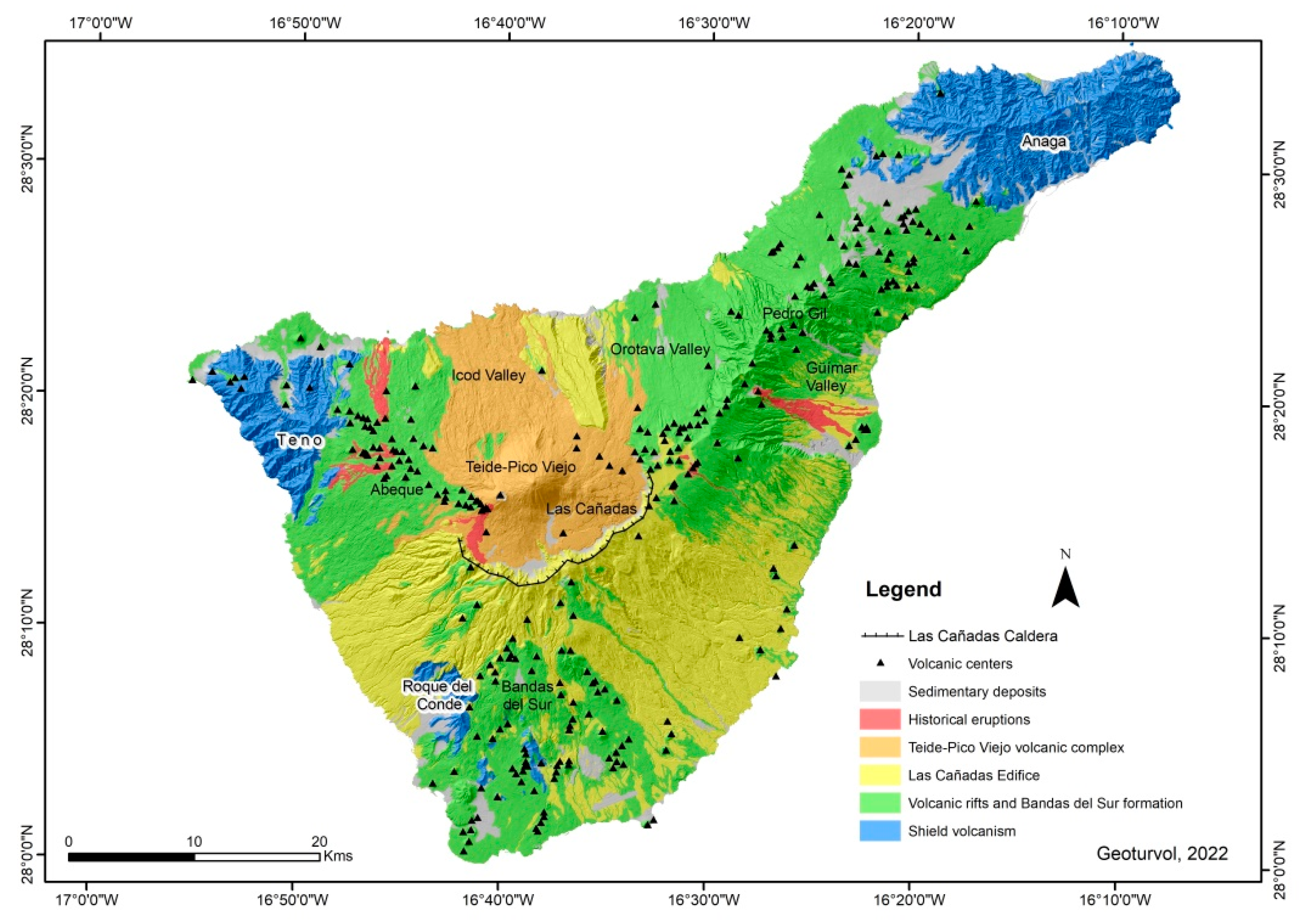
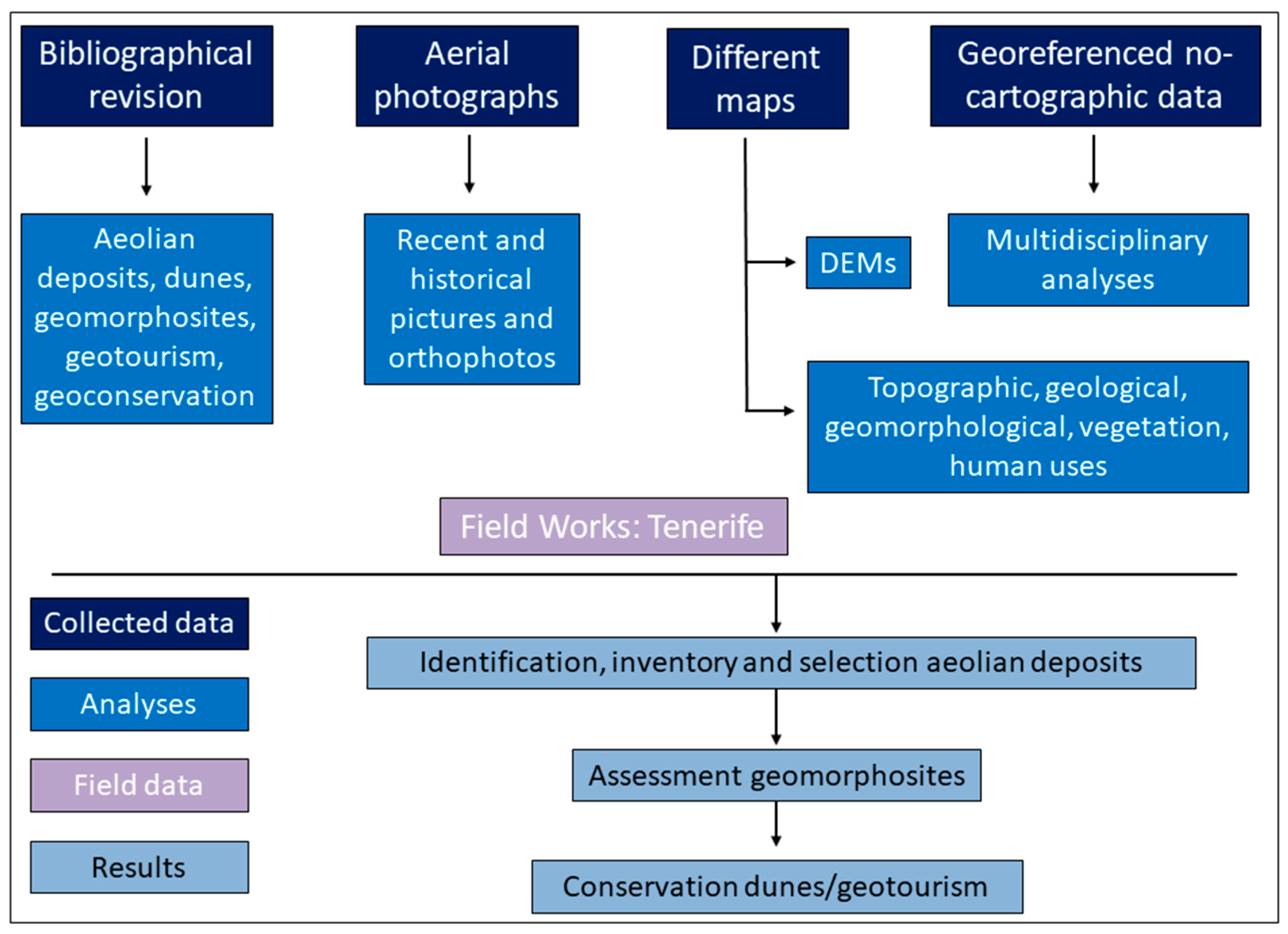
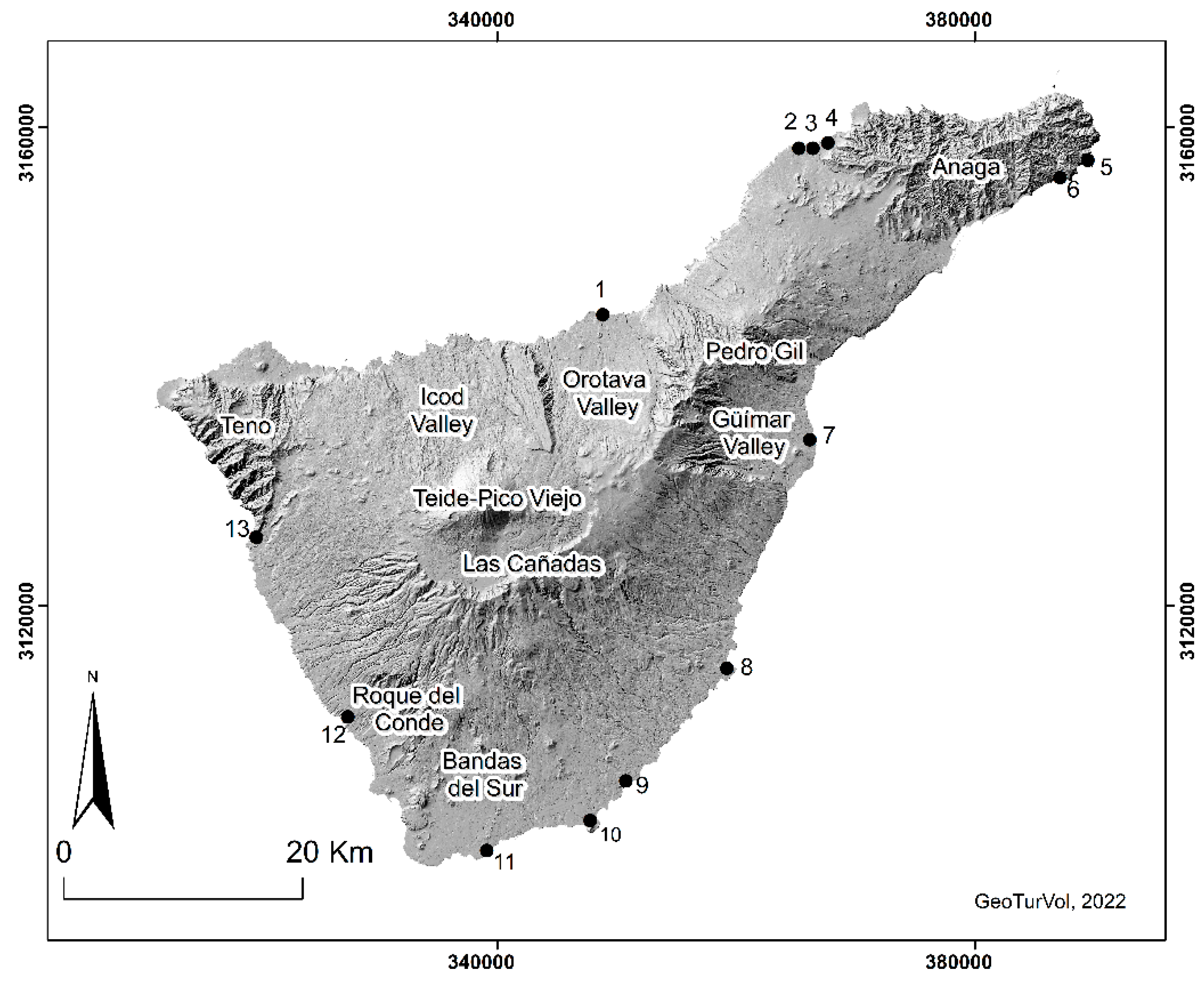
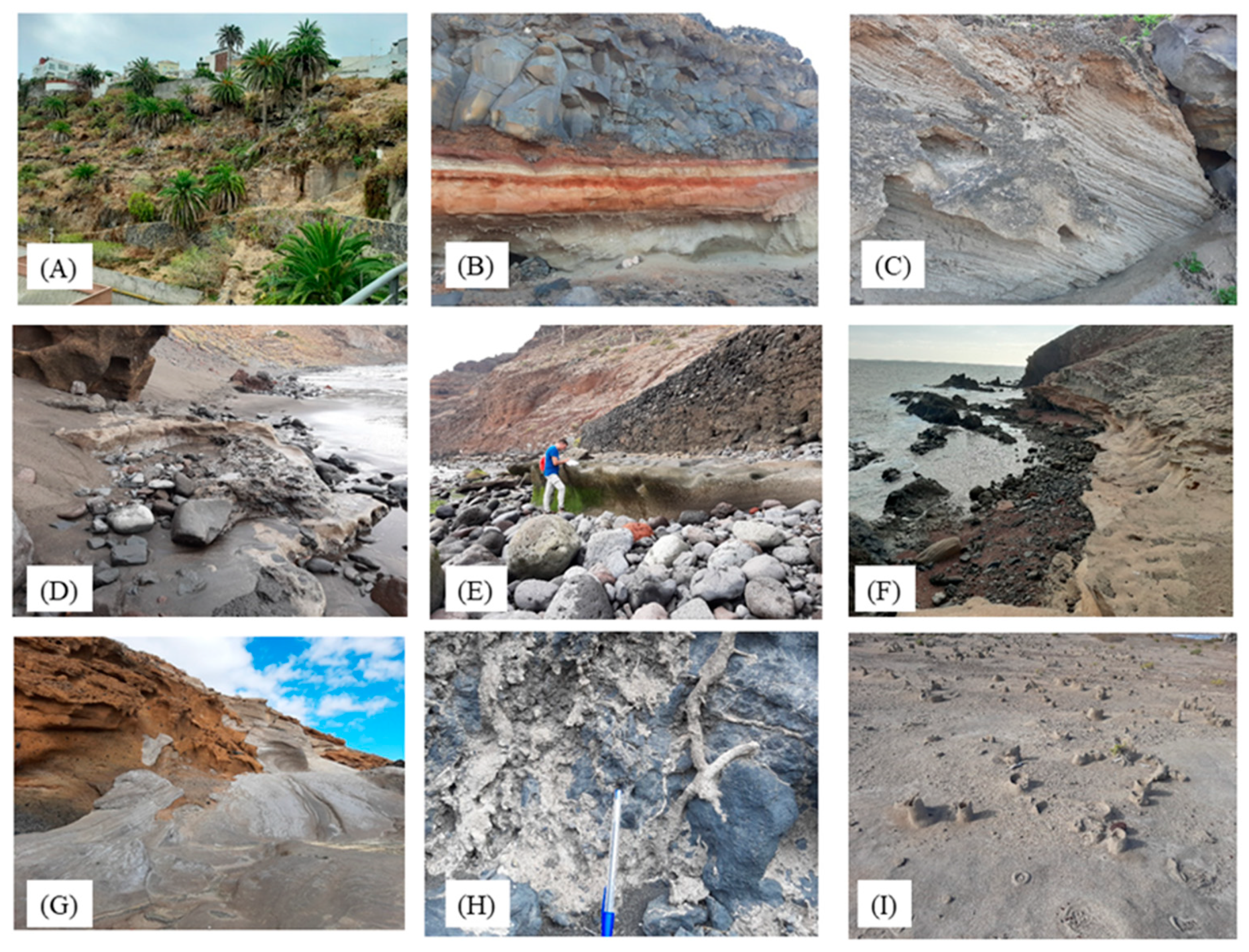
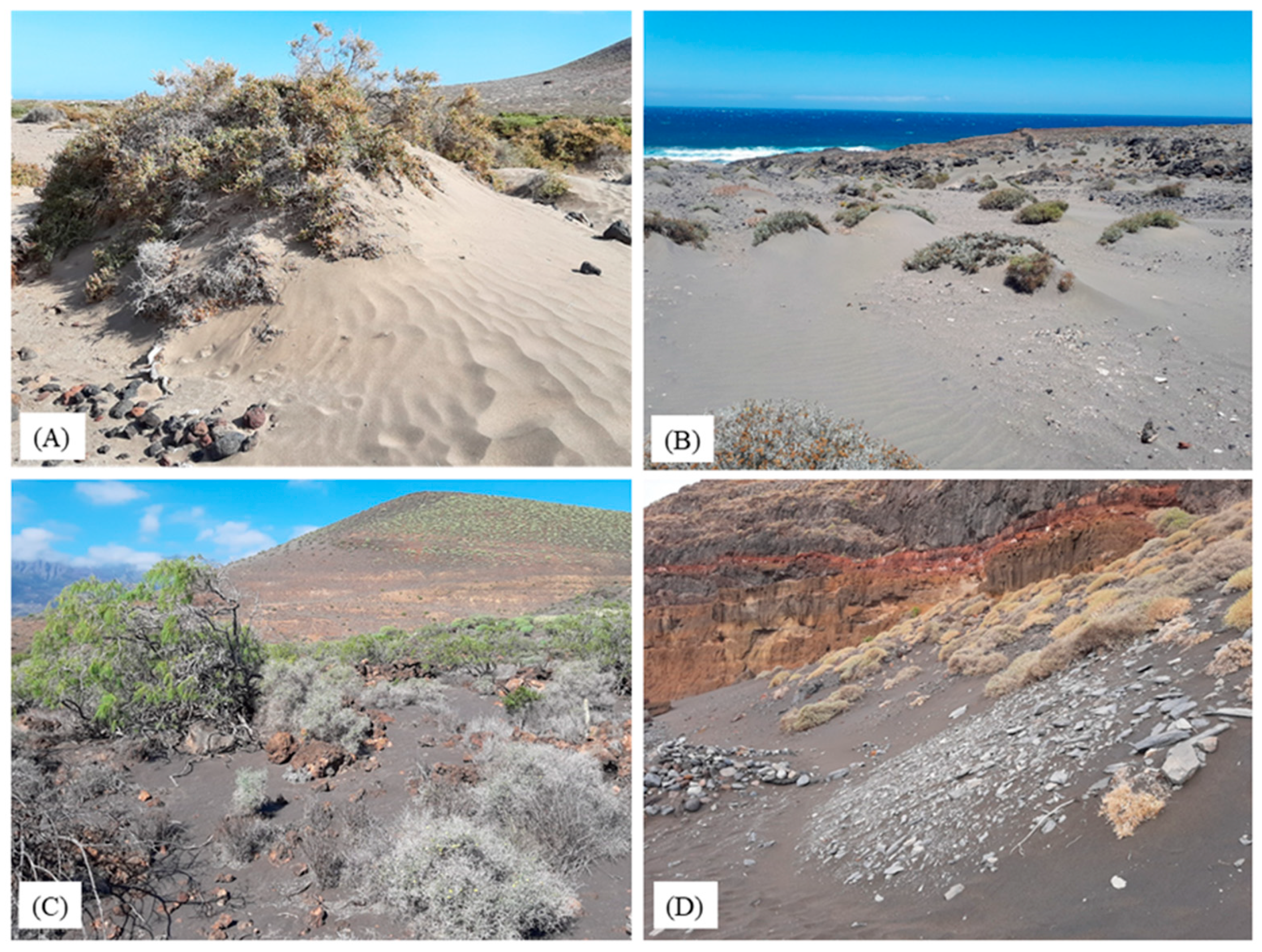

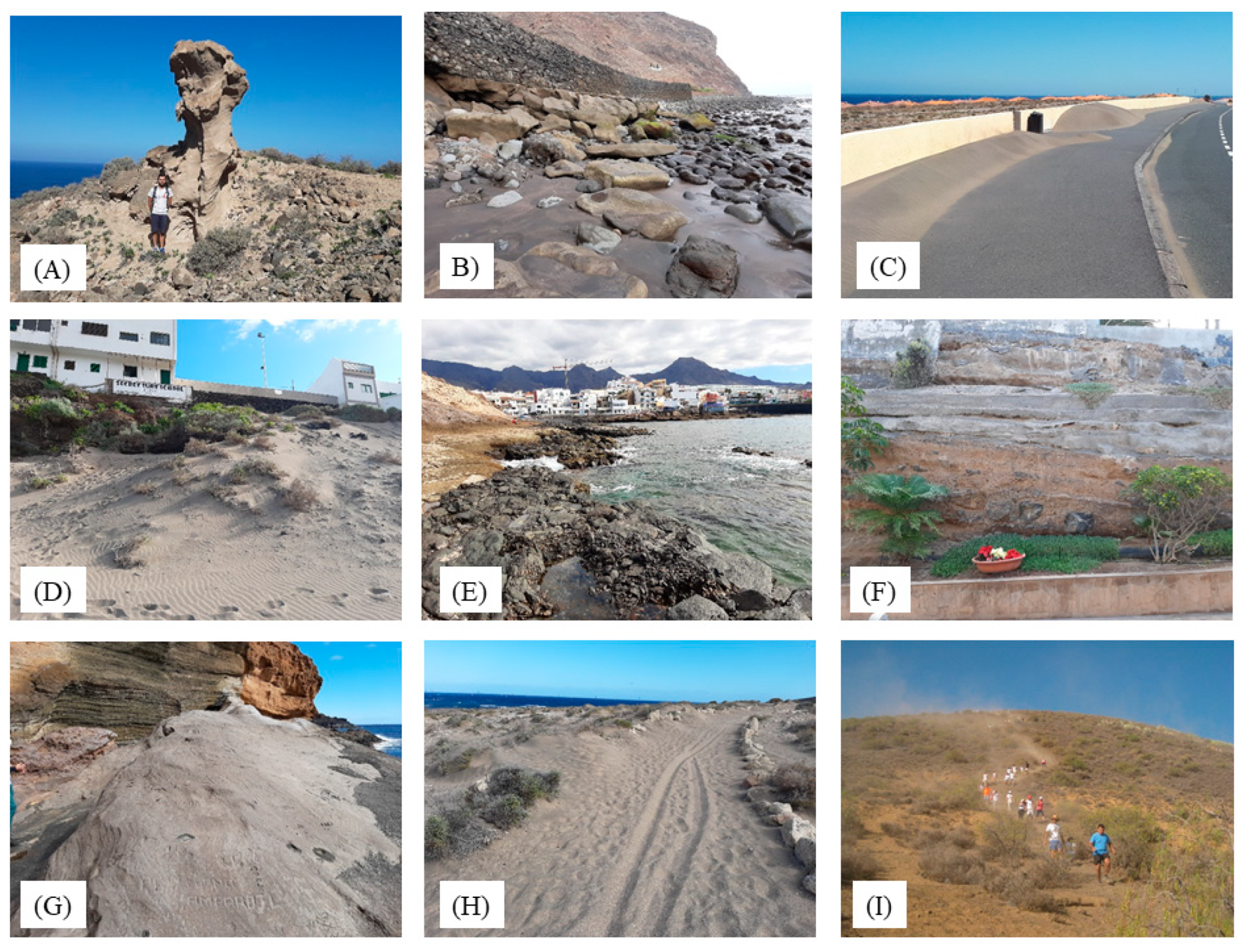
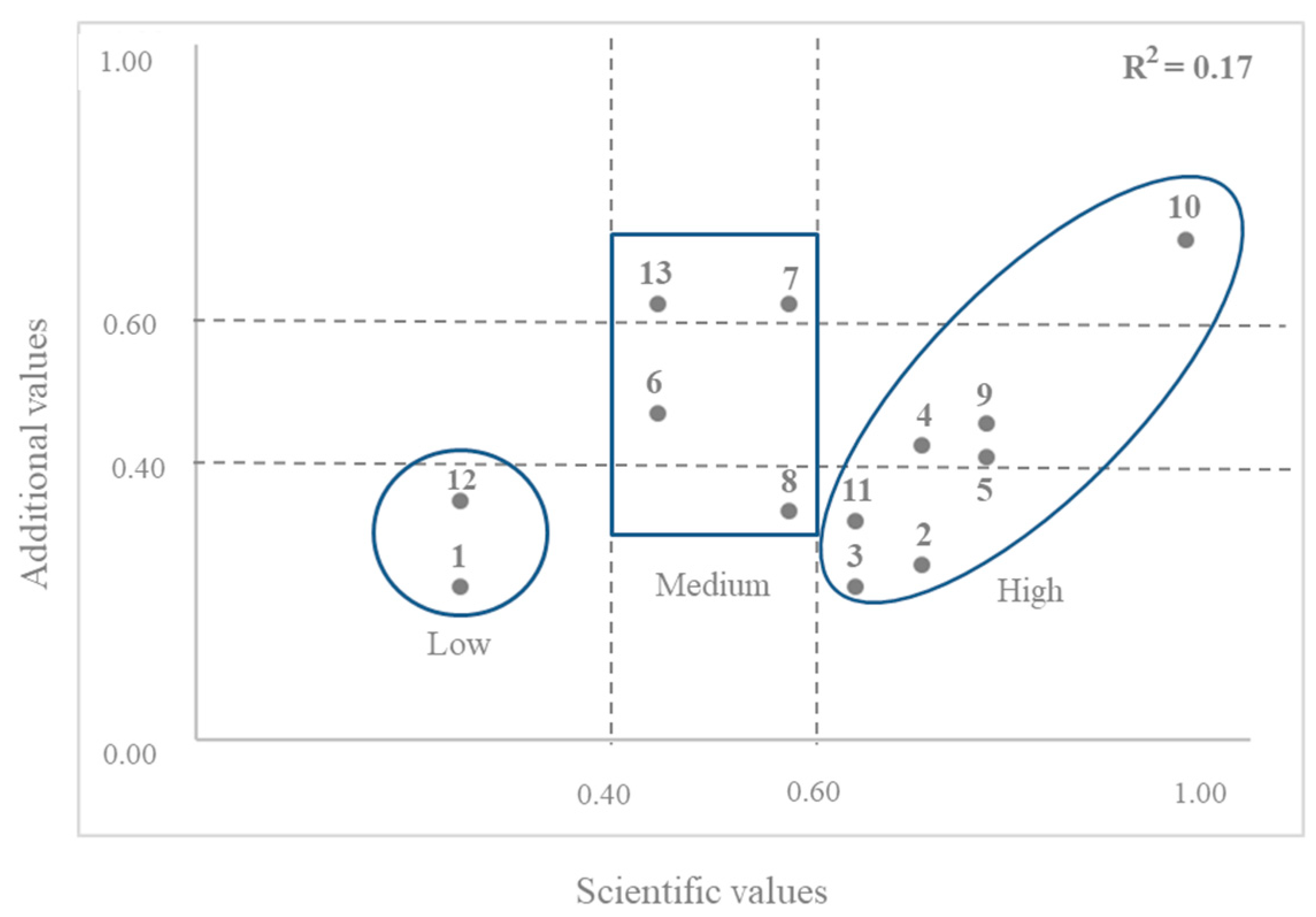
| Scientific Values | ||
| Criteria | Values | |
| Integrity (I) | 0 = Destroyed. 0.25 = Practically destroyed. 0.5 = Partially destroyed .0.75 = Slightly damaged 1 = Intact | |
| Representativeness (R) | 0 = Null. 0.25 = Weak. 0.5 = Moderate. 0.75 = High. 1 = Very high | |
| Rareness (Rz) | 0 = More than 7. 0.25 = Between 5 and 7. 0.5 = Between 3 and 4. 0.75 = Between 1 and 2 1 = Unique | |
| Palaeogeographical Interest (Ip) | 0 = Null 0.25 = Weak 0.5 = Moderate 0.75 = High 1 = Very high | |
| Additional Values | ||
| Criteria | Values | |
| Ecological | Ecological influence | 0 Without relation to biological features. 0.25 Occurrence of interesting fauna and/or flora. 0.50 One of the best places to observe interesting fauna and/or flora. 0.75 Geomorphological features are important for ecosystem(s). 1 Geomorphological features are crucial for the ecosystem(s). |
| Protected site | 0 = Unprotected. 0.25 = Local. 0.50 = Regional. 0.75 = National. 1 = International | |
| Aesthetic value | View points | 0 The site is only visible in situ or is not easily accessible. 0.25 The site is not readily accessible, but offers several points of view. 0.50 The site offers a few points of view because of the presence of visual obstacles. 0.75 The site has many points of view. 1 The site has many points of view and a large distance of observation. |
| Contrasts | 0 The site is monotonous: flat topography and solid colour. 0.25 The site shows some vertical development and we recognized three colours. 0.50 The topography is abrupt and we recognized up to 5 colours. 0.75 The site shows an abrupt topography and up to 7 colours are recognized. 1 The site shows a contrasting and abrupt topography and more than 7 colours are recognized. | |
| Cultural value | Religious and symbolic importance | 0 The site does not present any religious importance. 0.25 Local. 0.50 Provincial or regional. 0.75 National. 1 International. |
| Historical importance | 0 The site does not present any historical importance. 0.25 Local. 0.50 Provincial or regional. 0.75 National. 1 International. | |
| Artistic and literature importance | 0 The site does not present any artistic importance. 0.25 Local. 0.50 Provincial or regional. 0.75 National. 1 International. | |
| Geohistorical importance | 0 The site is not at the origin of any discovery through the history of Earth Sciences. 0.25 The site, due to the scientific development or demonstration of a process, is locally known. 0.50 The site, due to the scientific development or demonstration of a process is known in regional and / or provincial. 0.75 The site, due to the scientific development or demonstration of a process, is known nationally. 1 The site, due to the scientific development or demonstration of a process, is known internationally. | |
| Economic value | Economic products | 0 The site is not generating any income. 0.25 The site is known, but it is the cause of indirect benefits (tourism). 0.50 The site is a source of income, but is threatened by human activity that can deplete it. 0.75 The site is managed by a company; it does not cause it any impact. 1 The site allows direct management of an autonomous company that causes it no negative impact. |
| Location | Nebkha | Shadow Dune | Eco Dune | Climbing Dune | Falling Dune | Paleo-Dune | Sand Sheet | Rhizo-Lithes | Protected Area |
|---|---|---|---|---|---|---|---|---|---|
| Pto. La Cruz | P | ||||||||
| Jover | P | ||||||||
| Milán | P | ||||||||
| Bajamar | P | ||||||||
| Antequera | P | P | P | P | F | ||||
| Igueste | P | ||||||||
| M. Güimar | P | A | |||||||
| P. de Abona | A | A | F | P | P | F | |||
| M. Pelada | A | A | F | A | P | ||||
| El Médano- Montaña Roja | A | A | P | P | F | P | A | ||
| M. Amarilla | P | ||||||||
| La Caleta | P | ||||||||
| Los Gigantes | P |
| Scientific Values | ||||||
| Dunes | Ranking | Integrity | Representativeness | Rareness | Palaeogeographical Interest | Average |
| El Médano | 1 | 0.75 | 1 | 1 | 1 | 0.94 |
| M. Pelada | 2 | 0.75 | 0.75 | 0.75 | 0.75 | 0.75 |
| Antequera | 2 | 0.75 | 0.75 | 0.75 | 0.75 | 0.75 |
| Jover | 3 | 0.5 | 0.5 | 0.75 | 1 | 0.69 |
| Bajamar | 3 | 0.5 | 0.5 | 0.75 | 1 | 0.69 |
| Amarilla | 4 | 0.5 | 0.75 | 0.75 | 0.5 | 0.63 |
| Milán | 4 | 0.25 | 0.5 | 0.75 | 1 | 0.63 |
| M.Güímar | 5 | 0.75 | 0.5 | 0.75 | 0.25 | 0.56 |
| Abades | 5 | 0.25 | 0.75 | 0.75 | 0.5 | 0.56 |
| Gigantes | 6 | 0.25 | 0.25 | 0.75 | 0.5 | 0.44 |
| Igueste | 6 | 0.25 | 0.75 | 0.25 | 0.5 | 0.44 |
| Puerto Cruz | 7 | 0.25 | 0.25 | 0.25 | 0.25 | 0.25 |
| Caleta | 7 | 0.25 | 0.25 | 0.25 | 0.25 | 0.25 |
| - | Average | 0.46 | 0.58 | 0.65 | 0.63 | 0.58 |
| Additional Values | ||||||
| Dunes | Ranking | Ecological | Aesthetics | Cultural | Economics | Average |
| El Médano | 1 | 0.88 | 0.88 | 0.6 | 0.5 | 0.72 |
| Güímar | 2 | 1 | 0.75 | 0.5 | 0.25 | 0.63 |
| Gigantes | 3 | 0.63 | 0.63 | 0.38 | 0.25 | 0.63 |
| Igueste | 4 | 0.63 | 0.38 | 0.38 | 0.5 | 0.47 |
| M. Pelada | 5 | 0.63 | 0.63 | 0.31 | 0.25 | 0.45 |
| Bajamar | 5 | 0.88 | 0.5 | 0.06 | 0.25 | 0.45 |
| Antequera | 6 | 0.63 | 0.50 | 0.25 | 0.25 | 0.41 |
| Caleta | 7 | 0.63 | 0.25 | 0.25 | 0.25 | 0.34 |
| Abades | 8 | 0.63 | 0.25 | 0.19 | 0.25 | 0.33 |
| Amarilla | 9 | 0.38 | 0.38 | 0.25 | 0.25 | 0.31 |
| Jover | 10 | 0.13 | 0.50 | 0.13 | 0.25 | 0.25 |
| Milán | 11 | 0.13 | 0.50 | 0.25 | 0 | 0.25 |
| Puerto Cruz | 11 | 0.13 | 0.25 | 0.25 | 0.25 | 0.22 |
| - | Average | 0.56 | 0.49 | 0.29 | 0.27 | 0.41 |
| Geomorphosite | 1 | 2 | 3 | 4 | 5 | 6 | 7 | 8 |
|---|---|---|---|---|---|---|---|---|
| Puerto de la Cruz | ||||||||
| Jover | ||||||||
| Milan | ||||||||
| Bajamar | ||||||||
| Antequera | ||||||||
| Igueste | ||||||||
| Malpaís Güímar | ||||||||
| Abades | ||||||||
| Montaña Pelada | ||||||||
| Médano-Montaña Roja | ||||||||
| Montaña Amarilla | ||||||||
| La Caleta | ||||||||
| Los Gigantes |
Publisher’s Note: MDPI stays neutral with regard to jurisdictional claims in published maps and institutional affiliations. |
© 2022 by the authors. Licensee MDPI, Basel, Switzerland. This article is an open access article distributed under the terms and conditions of the Creative Commons Attribution (CC BY) license (https://creativecommons.org/licenses/by/4.0/).
Share and Cite
Marrero-Rodríguez, N.; Dóniz-Páez, J. Coastal Dunes Geomorphosites to Develop the Geotourism in a Volcanic Subtropical Oceanic Island, Tenerife, Spain. Land 2022, 11, 426. https://doi.org/10.3390/land11030426
Marrero-Rodríguez N, Dóniz-Páez J. Coastal Dunes Geomorphosites to Develop the Geotourism in a Volcanic Subtropical Oceanic Island, Tenerife, Spain. Land. 2022; 11(3):426. https://doi.org/10.3390/land11030426
Chicago/Turabian StyleMarrero-Rodríguez, Néstor, and Javier Dóniz-Páez. 2022. "Coastal Dunes Geomorphosites to Develop the Geotourism in a Volcanic Subtropical Oceanic Island, Tenerife, Spain" Land 11, no. 3: 426. https://doi.org/10.3390/land11030426
APA StyleMarrero-Rodríguez, N., & Dóniz-Páez, J. (2022). Coastal Dunes Geomorphosites to Develop the Geotourism in a Volcanic Subtropical Oceanic Island, Tenerife, Spain. Land, 11(3), 426. https://doi.org/10.3390/land11030426







